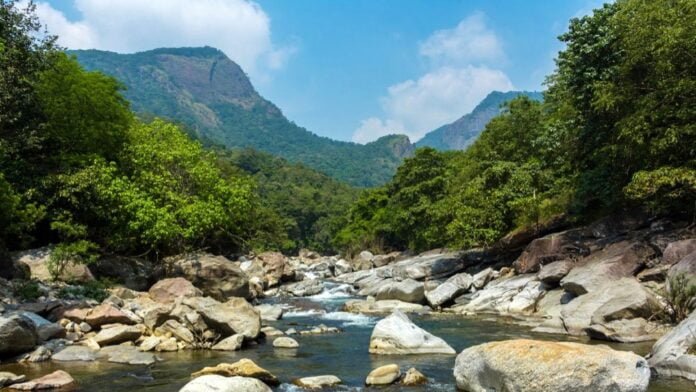
Silent Valley of Kerala is a national park that is located in the Nilgiri Hills in Palakkad district. It is one of the last remaining stretches of evergreen forests in Kerala and one of the largest in India. It is also a part of the Nilgiri Biosphere Reserve, which is a UNESCO World Heritage Site. Silent Valley is home to a rich variety of flora and fauna, including many endemic and endangered species. It is also a place of historical and cultural significance, as it is associated with Lord Buddha, Mahavira, and King Bimbisara.
Forest Types in Silent Valley
Silent Valley has four types of vegetation, which reflect the different altitudes, rainfall, and soil conditions in the area. These are:
- West Coast Tropical Evergreen Forest: This is the dominant forest type in Silent Valley, covering about 60% of the area. It is found at an altitude range of 600 to 1100 m and receives an annual rainfall of 1500 to 5000 mm. The trees in this forest are tall (up to 45 m) and dense, with many species growing together. The canopy is so thick that it blocks most of the sunlight from reaching the ground. The forest floor is covered with ferns, mosses, orchids, and other epiphytes. The undergrowth consists of cane, bamboo, and palms. Some of the common tree species in this forest are Mesua ferrea, Palaquium ellipticum, Cullenia exarillata, Calophyllum elatum, Artocarpus heterophyllus, etc.
- Southern Subtropical Broad Leaved Hill Forest: This is a transitional forest type between evergreen and moist deciduous forests. It is found at an altitude range of 1300 to 1800 m and receives an annual rainfall of 2500 to 3500 mm. The trees in this forest are shorter (up to 30 m) and less dense than the evergreen forest. The canopy is more open and allows more sunlight to reach the ground. The forest floor is covered with grasses, herbs, and shrubs. The undergrowth consists of bamboo, cane, and climbers. Some of the common tree species in this forest are Bischofia javanica, Hopea ponga, Mangifera indica, Myristica dactyloides, etc.
- Southern Montane Wet Temperate Forest: This is a stunted forest type that occurs at high altitudes (above 1900 m) where the climate is cold and wet. It receives an annual rainfall of more than 5000 mm. The trees in this forest are dwarfed (up to 10 m) and twisted by strong winds. The canopy is sparse and irregular. The forest floor is covered with mosses, lichens, ferns, and orchids. The undergrowth consists of rhododendrons, vacciniums, myrtles, etc. Some of the common tree species in this forest are Elaeocarpus serratus, Eugenia spp., Holigarna beddomei, etc.
- Grassland: This is a non-forest type that occurs on hilltops and slopes where the soil is poor and rocky. It receives an annual rainfall of less than 1500 mm. The vegetation consists of grasses, sedges, herbs, and shrubs that can withstand drought and fire. Some of the common plant species in this type are Chrysopogon zeylanicus, Eragrostis spp., Strobilanthes spp., etc.
Forest Conservation in Silent Valley
Silent Valley has been a site of conservation efforts since the 1970s when a proposed hydroelectric project threatened to submerge a large part of the forest. A public campaign called Save Silent Valley was launched by environmentalists, scientists, writers, artists, and activists to oppose the project and protect the forest. The campaign succeeded in convincing the government to cancel the project and declare Silent Valley as a national park in 1980.
Since then, Silent Valley has been protected by various laws and policies such as the Wildlife Protection Act (1972), the Forest Conservation Act (1980), the Environment Protection Act (1986), etc. The park management has also taken various measures to conserve the forest such as patrolling, fire prevention, habitat restoration, research and monitoring, education and awareness, ecotourism development, etc.
Silent Valley is a precious natural heritage that needs to be preserved for future generations. It is a place where one can experience the beauty and diversity of nature and learn about its importance for our survival and well-being.

